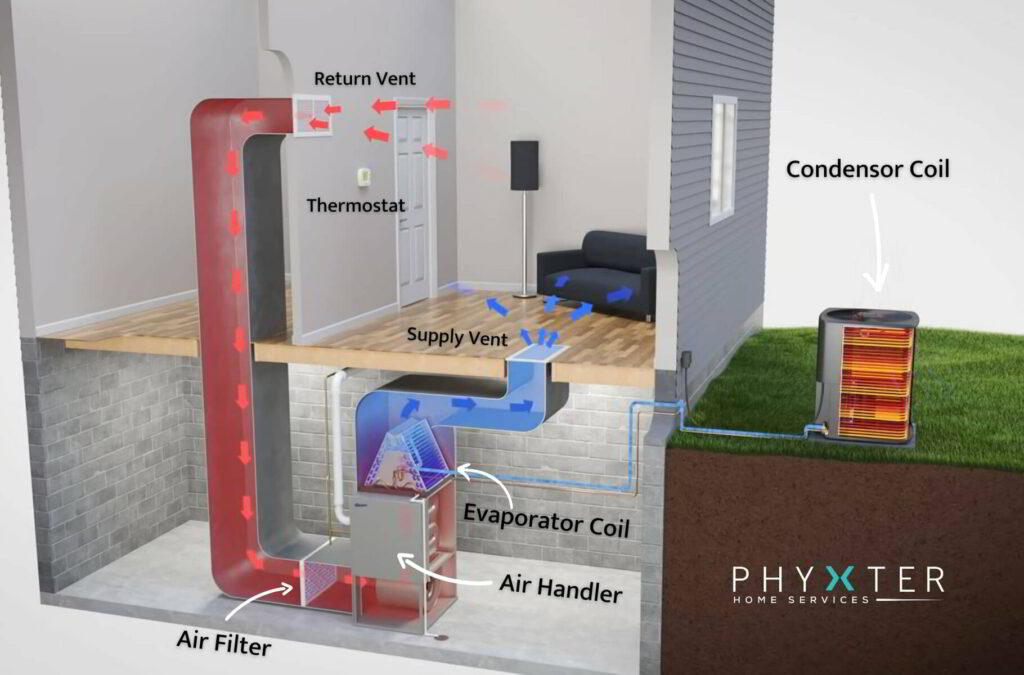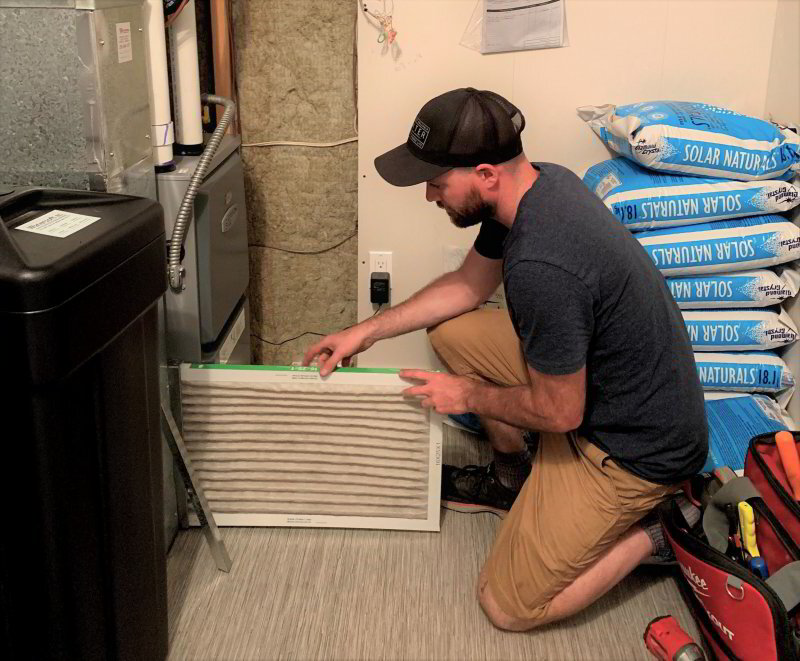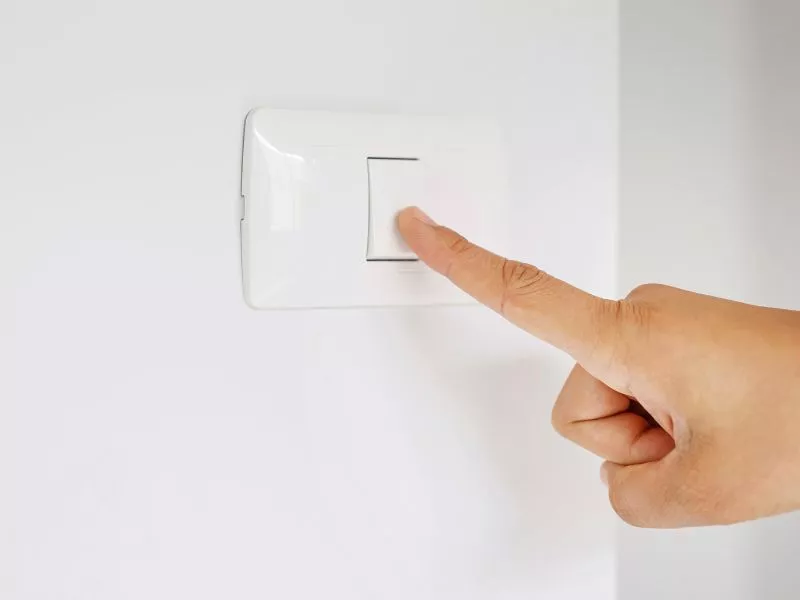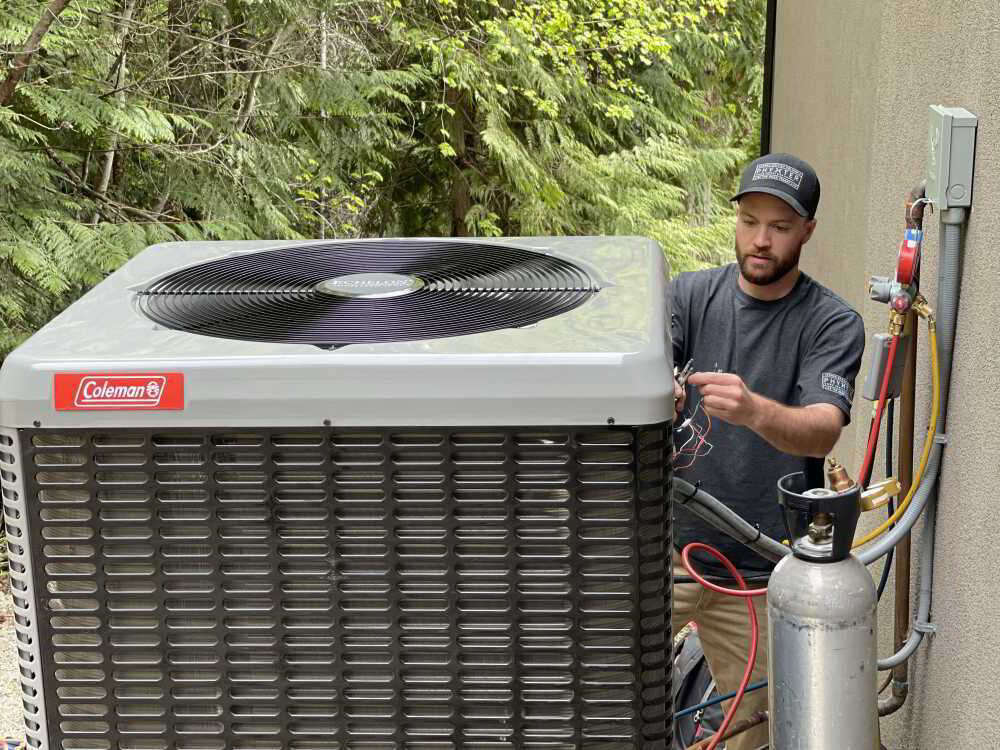If your air conditioning system won’t turn on, it can be very frustrating… to say the least.
If it’s in the middle of summer, you want to get it fixed fast, so it’s vital to troubleshoot a few essential things before you call in an HVAC professional, as this can save you a lot of time and – more importantly – money.
Some serious problems can cause these issues, but typically, you have about a 70% chance of solving the issue yourself when your AC doesn’t turn on.
This article will discuss some general issues that can keep your AC from turning on, reset your air conditioning unit, and hopefully, learn a few key steps to take if your air conditioner unit isn’t working.
Table of Contents
AC Unit Won’t Turn On – The Basics

I know that some of you are moonlighting as HVAC technicians, but this is even for you DIY homeowners… when an AC doesn’t turn on, you’ll need to understand some essential HVAC terms before we can explain how to troubleshoot it.
Otherwise, how will you know what we are talking about? So anyway, let’s discuss some common language.
Key Terms to Know When Your AC Won’t Turn On
When your air conditioning system won’t start up, you will need to check a few things yourself before calling in the HVAC professionals.
But how can I ask you to check your “condensing coil,” for instance, if you don’t even know what that is? This is the crash course…
❄️ Split AC Unit
A split unit is an AC with two essential parts: an inside unit (in a basement or utility room inside your home) and an outside AC unit.
❄️ Packaged AC Unit
A packaged HVAC unit is just one big unit with both parts normally located on the roof.
❄️ Condensing Coils
A condensing unit (or “condenser”) is the boxy-looking part of an outdoor unit.
❄️ Evaporator Coils
An evaporative coil is part of a split AC unit located inside an indoor air handler inside your home or in a utility room.
❄️ Thermostat
– Ok, come on…you have to know what this is, right? You’d be surprised… the thermostat is the control panel for your air conditioner located on the wall of your home somewhere.
❄️ Air Filter
– Your AC has an air filter located somewhere that is usually (not always) easy to change. Find your indoor air handler, and you will find your air filter.
You should be changing this every three months, so if you have no idea what I’m talking about, I think I just figured out the problem… just saying.
Why Your AC Won’t Turn On – The AC Crash Course.

I’m not going to go into the weeds here, but your cooling system won’t turn on for a reason.
So to help you troubleshoot your broken AC, let’s take a moment to discuss how your air conditioner actually works.
An air conditioner works by compressing a gas known as refrigerant, which, as we all know from the Joule-Thomson Effect (because we all paid attention to physics, right…?), will cause it to heat up.
If we were to do this outside of your residence, the refrigerant would release the heat that was once inside your house.
This is what the condenser coil or condensing unit on your air conditioner does, and you’ll need to know this if your AC isn’t working.
So, since everyone reading this is smart, I’m sure we know that the opposite would happen if we were to expand the same refrigerant, right?
Yes, it would get really cold!
So if we did that inside our home, that would cause the air in our home to get colder.
That is what the evaporator coil in your home does.
📚 AC for Dummies
Air conditioning works by expanding gas rapidly inside a coil, causing the air inside your home to cool when it is blown over it.
So why does this matter? When AC units won’t turn on, it’s because one of these things isn’t happening.
Don’t get too lost in the details…just remember that air conditioners are really simple pieces of machinery…
Look, only a few reasons your air conditioner won’t turn on.
So, let’s take a look at some of the common air conditioner problems and get your AC up and running again.
Step 1: Check Your Thermostat

I know it sounds silly, but if I told you how many times I used to get called out to a residential home because an AC wouldn’t switch on, only to find out it was actually an overenthusiastic wife waging a cold war on her husband for keeping the temperature too low…you’d be surprised.
Make sure that your AC thermostat:
- Has power. It is set to COOL.
- Has the temperature set at least 3 degrees below the current room temperature.
If the thermostat is battery powered, those batteries might need to be replaced.
Otherwise, ensure that some rodent hasn’t eaten through the wires!
Ensure that it is in COOL mode and that the temperature is set a few degrees below the current one. If any of these are not true, then that’s why your AC won’t turn on!
For more information about troubleshooting your Thermostat, check out this article: Thermostat Not Working? Read our Quick Fix It Guide!
Step 2: Check Your Air Filter

We covered how your AC works, so let’s envisage that something else was keeping the air in your home from going over the evaporative coil that is supposed to cool the air.
Wouldn’t that coil get colder and colder without the air in your home heating it up?
If the evaporator coil got too cold, eventually, it would freeze up and block the airflow in your home.
If you didn’t follow me, that’s ok.
However, if you have a clogged air filter, sometimes your AC won’t turn on.
Usually, it results in your air conditioner running but not cooling your home.
Still, it can also keep your AC from turning on if it’s bad enough!
Your AC’s filter is typically located at the air return of your AC (the big grille that sucks air into it instead of blowing it out) or near the evaporative coil.
So go check this filter now!
For a central air conditioner, you will find it somewhere contained within the indoor unit air handler.
✔️ If you find a dirty air filter, then replace it.
✔️ If your filter isn’t clogged, then replace it anyway!
AC filters can be clogged but still look clean… the only way of knowing if it is fresh is to replace them and do so every three months at a minimum!
Just make sure you put it in the right way!
Step 3: Check Your Circuit Breakers

If you have a tripped circuit breaker (shocker, I know), your air conditioner won’t turn on.
But why do circuit breakers trip?
A circuit breaker is a safety feature.
It is designed to turn off the power to an electrical component like your air conditioner if there is a power surge.
More than likely, when this happens, it can be from harmless power surges from the grid or when your partner turns on a high-amp power tool and trips the breaker.
Locate the AC circuit breaker marked on your home’s main electrical panel.
The large circuit breaker panel (sometimes called a fuse box) which looks like a large metal box is located inside or outside your house.
It will be marked as “A/C,” “HVAC,” or “air…” or something like that.
If none of your circuit breakers are marked…haha! Have fun with that!
Turning off the wrong one won’t hurt anything, but it’ll take you a bit of the process of elimination to figure them all out…just saying.
Turn this breaker all the way off.
Wait a few seconds.
Now turn the breaker on again.
Check your air conditioner.
There are a couple of essential tips to keep in mind when dealing with circuit breakers:
Circuit breakers can look ON, even when they are tripped.
So, ensure that you turn it off fully, then back on again. Check out this article to learn more about circuit breaker failure.
Only reset a circuit breaker ONCE! If it keeps tripping off, there’s a problem, and you risk starting an electrical fire if you keep turning it back on.
If this is the case, you’re done—time to call out an HVAC technician.
Step 4: Check Your AC Drain Pan

A drain pan is underneath your HVAC system, which is meant to accumulate any residual condensation that your AC couldn’t drain out.
If your AC drain pan is complete, it may have triggered the float switch.
This switch is designed to stop your AC from flooding your house with residual condensation.
Good idea, right? This is especially useful in humid areas…
Over time – especially in humid climates – these drains and the attached condensate drain line can become clogged, then spill into your drain pan.
Your drain pan should also have a secondary drain (to keep this from happening).
Once your drain pan drain is congested and your drain pan itself is full, this should trigger the float switch to turn your AC off.
Your AC won’t turn back on until you clean out your drains, and get the float switch back into the DOWN position.
Typically, HVAC technicians use compressed air to clear the drain line during repair and servicing (ahem…hint, hint).
Still, you can actually clear a drain line out by cupping your hands together and blowing really hard… forewarning, it’s disgusting. And don’t give yourself a heart attack from blowing too hard.
Step 5: Check the AC Shut off Switch

So you have completed all of the above, and it still won’t switch on.
Did you ever ask yourself, “did I turn the AC switch off?”
Probably not…but that might be precisely what you did.
Furnaces, air conditioners, heat pump, cooling equipment and other large appliances in your home are often installed with an ON/OFF safety switch that looks just like a light switch.
This reset switch is there so that lazy HVAC technicians – like me – can easily remove the power supply while troubleshooting and servicing.
Look at the inside area of your HVAC system and around it on the walls for a light switch.
It should be relatively close to the AC system itself.
When/if you find one, switch it (UP isn’t always ON, don’t ask me why…) and try your AC again.
Although this is one of the easiest things to check, we have it last on our list because, let’s face it, if you knew there was a switch there, it’s probable that you switched it off and forgot about it?
Maybe, maybe not.
What to Expect Next if Your AC Unit Won’t Turn On

If your air conditioner still won’t turn on after all of this, then I’m afraid it’s time to call in the professionals.
The nice part is that you have a list of things to tell them it isn’t (they will double-check, though…ahem…just in case…).
Here is a great tip to keep in mind when they come out to look at your AC:
Use a reputable contractor. Make sure they are certified and licensed.
Check out their reviews online to see their history in dealing with customers.
Now, If your AC isn’t working, it may be time to replace it.
Since we ruled out most of the simple AC issues, it’ll probably be a seized blower motor or a compressor (sorry).
The average price for these types of repairs – since you asked – is a bit pricey. So take your heart medication, and we’ll have a look in our next section.
Here Are Some Average AC Repair Costs in 2024 (USD)
- Compressor replacement: $1300-$2500 (depending on size and type)
- Condenser fan motor replacement: $150-$300
- Refrigerant leak detection & repair: $200-$1500
- Circuit board replacement: $150-$700
- AC compressor repair hard start kit: $100-$250
- Replace blown fuse, circuit breaker or relay: $50-$300
- Thermostat replacement: $140-$350 (depending on model)
- In-situ Evaporator Coil Cleaning: $100 – 400 (depending on model)
- AC refrigerant recharge: $155-$650 (refrigerant is expensive)
- Evaporator coil replacement: $650-$2400
- Condensate pump replacement: $100-$450
- Capacitor or contactor replacement: $100-$250
- Entire new AC system? Discuss this with your local HVAC contractor.
Final Thoughts on When Your AC Won’t Turn On
It can be frustrating and uncomfortable when your air conditioner won’t turn on.
But hopefully, this article on troubleshooting when your air conditioner won’t turn on helped get you to where you need to be. If not, then it’s time to call in the professionals.
If you live in the Okanagan Valley, give us a call. We can set you up with the right HVAC system for your home, professionally installed by the best HVAC technicians on the market.
Dealing with other common AC problems? Check out: Top 18 Common AC Problems and Solutions

![Help! My AC Won't Turn On [2022] 5 Troubleshooting Steps for a Broken AC | Phyxter Home Services](https://phyxter.ai/wp-content/uploads/2022/08/My_AC_Wont_Turn_On-4128329-1024x675.jpg)